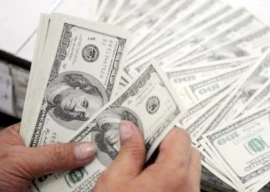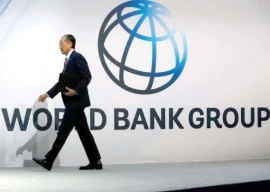
The rupee’s uptrend continued for the sixth successive day on Friday as the currency closed at a two-and-a-half-month high of Rs174.48 against the US dollar in the inter-bank market after exporters began selling the greenback.
Exporters returned to selling counters as the market expected increased inflow of foreign currencies from multiple sources following the resumption of International Monetary Fund’s (IMF) $6 billion loan programme a couple of days ago.
Pakistan on Friday received a loan tranche of $1.053 billion from the IMF, according to the State Bank of Pakistan (SBP).
The rupee made a notable recovery of Rs1.04 (or 0.6%) on Friday. It was the biggest rebound in a day over the past two and a half months. With this, the currency has cumulatively gained Rs2.5 (or 1.41%) against the greenback in the past six consecutive working days.
“I do not expect the rupee to recover beyond Rs174 against the US dollar,” Pak-Kuwait Investment Company Head of Research Samiullah Tariq said while talking to The Express Tribune.
Earlier, the rupee hit an all-time low of Rs178.24 against the dollar on December 29, 2021.
The receipt of IMF loan tranche has increased the country’s foreign exchange reserves by $1 billion. The reserves stood at $15.7 billion in the week ended January 28, 2022, according to the central bank’s data.
The reserves buildup has increased the country’s balance of international payments and helped reduce pressure on the rupee.
Recently, the central bank asked exporters to bring their export proceeds within 120 days instead of the earlier permissible limit of 190 days.
“The move is aimed at increasing inflows into the inter-bank market. Such measures have stared bearing fruit,” remarked Arif Habib Limited Head of Research Tahir Abbas.
“The resumption of IMF programme is a major trigger for the latest recovery of the rupee,” commented KASB Securities Head of Research Yousuf Rahman.
It has enabled the country to attract inflows from other global sources as well, he said.
Pakistan has planned to launch Eurobond worth around $1 billion in the international market soon.
Earlier, it successfully raised $1 billion by selling Sukuk (Shariah-compliant bond) in the global market.
In addition to this, the World Bank and the Asian Development Bank (ADB) are expected to make fresh lending for various projects and budgetary support. All these inflows will build the foreign exchange reserves and defend the rupee.
Secondly, the rupee has received support from the contraction in trade deficit as the import bill dropped significantly while export earnings maintained their uptrend in January.
In this backdrop, “the current account deficit is expected to fall below $1 billion in January 2022 compared to a four-year high of $1.9 billion in December 2021,” Abbas said.
Pakistan is estimated to raise new debt worth around of $22-23 billion by the end of June 2022 to improve its balance of payment. The inflows would mostly be used to pay off old debt and maintain foreign exchange reserves at or around the current levels. Accordingly, rupee would stay near the current level in the short run.
“Later on, the rupee may depreciate to around $179-180 against the greenback by the end of June 2022,” Rahman said.
Saving rates slashed
The government has revised down the rates of profit on saving certificates by 42-70 basis points on some of the national saving schemes “in the wake of drop in yield of three to 10-year Pakistan Investment Bonds (PIBs) in the secondary market,” Rahman said.
The government reinvests the funds received from investors into the PIBs
The rate of profit on Behbood and Pension certificates were revised down by 72 basis points each to 12.24%.
The rate of return on regular income certificates was slashed by 48 basis points to 10.32%.
The return on special savings was cut by 40 basis points to 10%.
The government, however, increased the rate of return by 100 basis points on saving accounts to 8.25%.
Published in The Express Tribune, February 5th, 2022.
Like Business on Facebook, follow @TribuneBiz on Twitter to stay informed and join in the conversation.




1731916090-0/sabrina-(3)1731916090-0-165x106.webp)













COMMENTS
Comments are moderated and generally will be posted if they are on-topic and not abusive.
For more information, please see our Comments FAQ